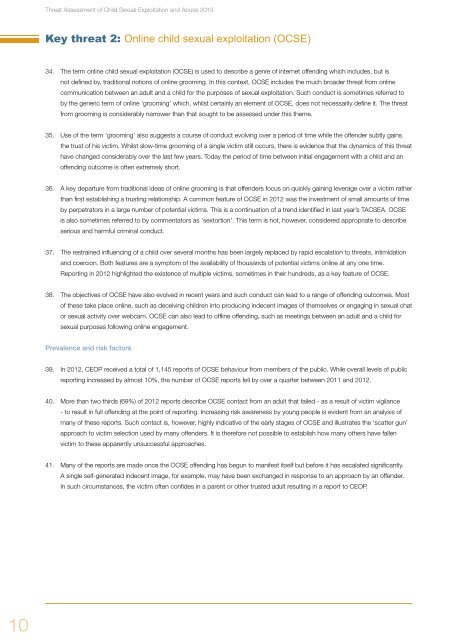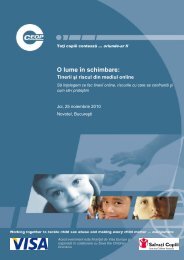Threat Assessment of Child Sexual Exploitation and Abuse - Ceop
Threat Assessment of Child Sexual Exploitation and Abuse - Ceop
Threat Assessment of Child Sexual Exploitation and Abuse - Ceop
Create successful ePaper yourself
Turn your PDF publications into a flip-book with our unique Google optimized e-Paper software.
<strong>Threat</strong> <strong>Assessment</strong> <strong>of</strong> <strong>Child</strong> <strong>Sexual</strong> <strong>Exploitation</strong> <strong>and</strong> <strong>Abuse</strong> 2013<br />
Key threat 2: Online child sexual exploitation (OCSE)<br />
34. The term online child sexual exploitation (OCSE) is used to describe a genre <strong>of</strong> internet <strong>of</strong>fending which includes, but is<br />
not defined by, traditional notions <strong>of</strong> online grooming. In this context, OCSE includes the much broader threat from online<br />
communication between an adult <strong>and</strong> a child for the purposes <strong>of</strong> sexual exploitation. Such conduct is sometimes referred to<br />
by the generic term <strong>of</strong> online ‘grooming’ which, whilst certainly an element <strong>of</strong> OCSE, does not necessarily define it. The threat<br />
from grooming is considerably narrower than that sought to be assessed under this theme.<br />
35. Use <strong>of</strong> the term ‘grooming’ also suggests a course <strong>of</strong> conduct evolving over a period <strong>of</strong> time while the <strong>of</strong>fender subtly gains<br />
the trust <strong>of</strong> his victim. Whilst slow-time grooming <strong>of</strong> a single victim still occurs, there is evidence that the dynamics <strong>of</strong> this threat<br />
have changed considerably over the last few years. Today the period <strong>of</strong> time between initial engagement with a child <strong>and</strong> an<br />
<strong>of</strong>fending outcome is <strong>of</strong>ten extremely short.<br />
36. A key departure from traditional ideas <strong>of</strong> online grooming is that <strong>of</strong>fenders focus on quickly gaining leverage over a victim rather<br />
than first establishing a trusting relationship. A common feature <strong>of</strong> OCSE in 2012 was the investment <strong>of</strong> small amounts <strong>of</strong> time<br />
by perpetrators in a large number <strong>of</strong> potential victims. This is a continuation <strong>of</strong> a trend identified in last year’s TACSEA. OCSE<br />
is also sometimes referred to by commentators as ‘sextortion’. This term is not, however, considered appropriate to describe<br />
serious <strong>and</strong> harmful criminal conduct.<br />
37. The restrained influencing <strong>of</strong> a child over several months has been largely replaced by rapid escalation to threats, intimidation<br />
<strong>and</strong> coercion. Both features are a symptom <strong>of</strong> the availability <strong>of</strong> thous<strong>and</strong>s <strong>of</strong> potential victims online at any one time.<br />
Reporting in 2012 highlighted the existence <strong>of</strong> multiple victims, sometimes in their hundreds, as a key feature <strong>of</strong> OCSE.<br />
38. The objectives <strong>of</strong> OCSE have also evolved in recent years <strong>and</strong> such conduct can lead to a range <strong>of</strong> <strong>of</strong>fending outcomes. Most<br />
<strong>of</strong> these take place online, such as deceiving children into producing indecent images <strong>of</strong> themselves or engaging in sexual chat<br />
or sexual activity over webcam. OCSE can also lead to <strong>of</strong>fline <strong>of</strong>fending, such as meetings between an adult <strong>and</strong> a child for<br />
sexual purposes following online engagement.<br />
Prevalence <strong>and</strong> risk factors<br />
39. In 2012, CEOP received a total <strong>of</strong> 1,145 reports <strong>of</strong> OCSE behaviour from members <strong>of</strong> the public. While overall levels <strong>of</strong> public<br />
reporting increased by almost 10%, the number <strong>of</strong> OCSE reports fell by over a quarter between 2011 <strong>and</strong> 2012.<br />
40. More than two thirds (69%) <strong>of</strong> 2012 reports describe OCSE contact from an adult that failed - as a result <strong>of</strong> victim vigilance<br />
- to result in full <strong>of</strong>fending at the point <strong>of</strong> reporting. Increasing risk awareness by young people is evident from an analysis <strong>of</strong><br />
many <strong>of</strong> these reports. Such contact is, however, highly indicative <strong>of</strong> the early stages <strong>of</strong> OCSE <strong>and</strong> illustrates the ‘scatter gun’<br />
approach to victim selection used by many <strong>of</strong>fenders. It is therefore not possible to establish how many others have fallen<br />
victim to these apparently unsuccessful approaches.<br />
41. Many <strong>of</strong> the reports are made once the OCSE <strong>of</strong>fending has begun to manifest itself but before it has escalated significantly.<br />
A single self-generated indecent image, for example, may have been exchanged in response to an approach by an <strong>of</strong>fender.<br />
In such circumstances, the victim <strong>of</strong>ten confides in a parent or other trusted adult resulting in a report to CEOP.<br />
10











